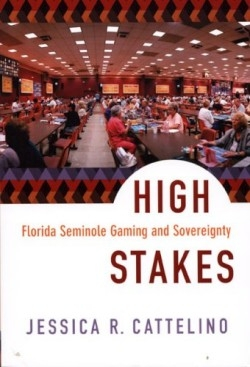High Stakes
Florida Seminole Gaming and Sovereignty
When the Seminole Tribe of Florida called a press conference in Times Square in December 2006 to announce its acquisition of Hard Rock International for $965 million, making it the first major multinational tribally owned company, it launched a media frenzy. For capturing the seeming contradiction of Seminole businessmen, dressed in traditional patchwork and orchestrating a major financial deal, the day may be the most symbolic in the tribe’s history. Anthropologist Jessica R. Cattelino, assistant professor at the University of Chicago, traces the relationship between Seminole culture and casino-era lucre in High Stakes: Florida Seminole Gaming and Sovereignty. Long considered the most traditional of Indian tribes, the Seminoles were the first to open a high stakes casino. By 2006, tribal net income from gaming was $600 million, with every tribal citizen receiving a bimonthly payment. How that check is spent is the crucial question of the book.
For the 3,300 Seminole Indians living in south Florida, questions of sovereignty and gambling complicate an otherwise charming welfare-to-windfall story. Non-Indians have accused them of losing their culture because they no longer rely economically on “tradition” jobs like alligator wrestling, cattle ranching, or crafting trinkets for tourists. But these occupations, insists Cattelino, were merely subsistence-level occupations—picturesque, but politically uninteresting. The Seminoles first tested their political autonomy by opening cigarette shops, untaxed and unregulated by the government, followed by their first foray into gambling with the 1979 opening of a casino in Hollywood, Florida. But their sovereign status, says Cattelino, is threatened with this seeming loss of cultural difference. In reality, the overt cultural distinctiveness has shifted stages: instead of culture being a direct means of making a pittance, Seminoles have been able to siphon hefty casino revenues into museums, language programs, and festivals.
Cattelino was granted unrestricted access to tribal records by the Seminoles for the book. During her year of fieldwork in 2000, she volunteered, essentially as a factotum, at the Ah-Tah-Thi-Ki Museum, while visiting reservations for interviews and surveys. Her arguments, which rest on the exquisitely imagined interplay between sovereignty and economy with references to political and economic theory, are replete with the more humble quotations of newly flush Seminoles—most of whom experienced reservation poverty, inadequate healthcare, and hectoring by the federal government. Though at times a little too credulous of the nostalgia of some of her subjects, Cattelino’s painstaking methodology and interest in the details of everyday tribal life leads her to ask suggestive questions and arrive at brilliant conclusions.
Highly recommended for readers of history, political theory, and economics.
Reviewed by
Korina Cornish
Disclosure: This article is not an endorsement, but a review. The publisher of this book provided free copies of the book to have their book reviewed by a professional reviewer. No fee was paid by the publisher for this review. Foreword Reviews only recommends books that we love. Foreword Magazine, Inc. is disclosing this in accordance with the Federal Trade Commission’s 16 CFR, Part 255.


